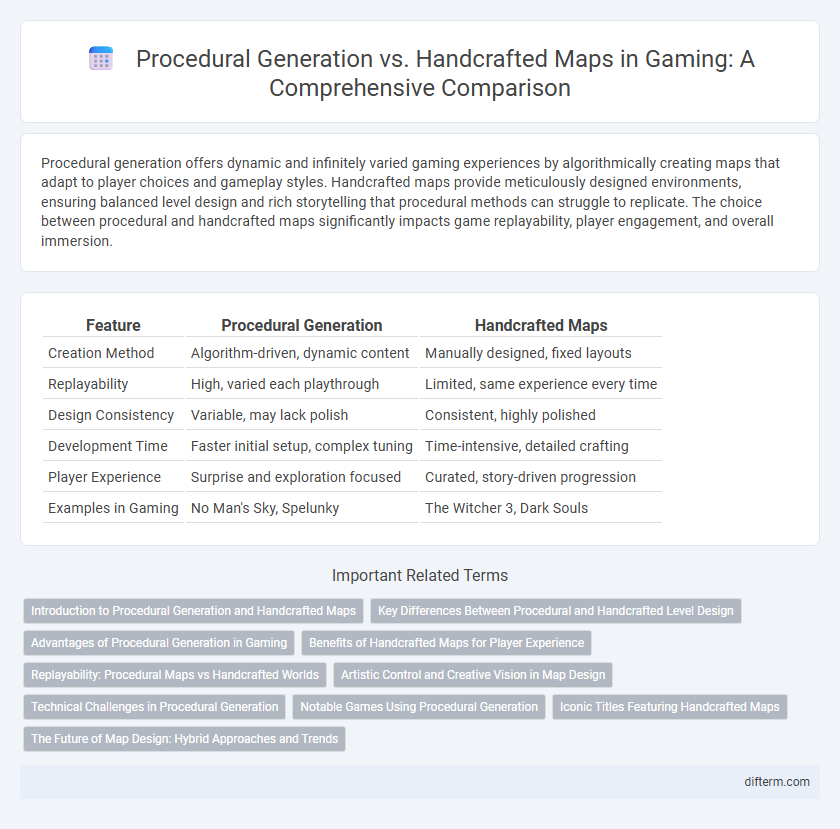Procedural generation offers dynamic and infinitely varied gaming experiences by algorithmically creating maps that adapt to player choices and gameplay styles. Handcrafted maps provide meticulously designed environments, ensuring balanced level design and rich storytelling that procedural methods can struggle to replicate. The choice between procedural and handcrafted maps significantly impacts game replayability, player engagement, and overall immersion.
Table of Comparison
| Feature | Procedural Generation | Handcrafted Maps |
|---|---|---|
| Creation Method | Algorithm-driven, dynamic content | Manually designed, fixed layouts |
| Replayability | High, varied each playthrough | Limited, same experience every time |
| Design Consistency | Variable, may lack polish | Consistent, highly polished |
| Development Time | Faster initial setup, complex tuning | Time-intensive, detailed crafting |
| Player Experience | Surprise and exploration focused | Curated, story-driven progression |
| Examples in Gaming | No Man's Sky, Spelunky | The Witcher 3, Dark Souls |
Introduction to Procedural Generation and Handcrafted Maps
Procedural generation uses algorithms to create game content dynamically, enabling unique and expansive environments with minimal manual input. Handcrafted maps are meticulously designed by developers to provide carefully curated experiences with specific gameplay elements and narrative flow. Both methods impact game design, balancing replayability and artistic control in gaming worlds.
Key Differences Between Procedural and Handcrafted Level Design
Procedural generation uses algorithms to create vast, unpredictable game environments, ensuring high replayability through dynamic level layouts and randomized elements. Handcrafted maps, designed meticulously by developers, offer carefully balanced challenges, narrative control, and unique visual storytelling tailored to specific player experiences. Key differences include procedural generation's scalability and variety versus handcrafted design's precision and intentionality in player engagement and pacing.
Advantages of Procedural Generation in Gaming
Procedural generation in gaming enables the creation of vast, unique environments that enhance replayability by offering players a fresh experience each session. This technique significantly reduces development time and resource costs compared to handcrafted maps, allowing developers to focus on core gameplay mechanics. Furthermore, procedural algorithms can dynamically adapt worlds based on player interaction, increasing immersion and unpredictability.
Benefits of Handcrafted Maps for Player Experience
Handcrafted maps provide meticulously designed environments that enhance player immersion through carefully placed landmarks, balanced enemy encounters, and intentional pacing. These maps offer unique and memorable gameplay moments crafted by designers, fostering a deeper emotional connection and encouraging exploration. The controlled design ensures consistent quality and supports narrative-driven experiences, which procedural generation often struggles to achieve.
Replayability: Procedural Maps vs Handcrafted Worlds
Procedural generation enhances replayability by creating unique, unpredictable maps every playthrough, keeping gameplay fresh and engaging. Handcrafted maps offer meticulously designed environments with carefully placed challenges but often lack variability, which can reduce long-term replay value. Players seeking endless exploration and diverse experiences prefer procedural worlds, while those valuing narrative and design detail lean towards handcrafted maps.
Artistic Control and Creative Vision in Map Design
Procedural generation offers vast, algorithm-driven environments but often limits artistic control and cohesive creative vision in map design. Handcrafted maps provide designers complete authority to sculpt intricate details, ensuring a unique and intentional player experience. Balancing procedural tools with manual fine-tuning can maximize creativity while maintaining playability and visual coherence.
Technical Challenges in Procedural Generation
Procedural generation in gaming faces significant technical challenges such as maintaining consistent gameplay balance and avoiding repetitive content while dynamically creating vast, diverse game worlds. Developers must refine algorithms to optimize resource management and minimize load times without sacrificing environmental complexity or visual fidelity. Ensuring procedural maps maintain narrative coherence and meaningful player interactions remains a critical hurdle compared to the controlled design of handcrafted maps.
Notable Games Using Procedural Generation
Notable games using procedural generation include "Minecraft," which creates vast, unique worlds with randomized terrains and biomes, and "No Man's Sky," offering a procedurally generated universe with over 18 quintillion planets. "Rogue Legacy" and "Spelunky" utilize procedural level design to enhance replayability by generating unpredictable dungeon layouts. These games leverage procedural algorithms to deliver diverse gaming experiences, contrasting handcrafted maps that provide meticulously designed, fixed environments.
Iconic Titles Featuring Handcrafted Maps
Iconic titles featuring handcrafted maps, such as The Legend of Zelda: Ocarina of Time, Dark Souls, and The Witcher 3: Wild Hunt, showcase meticulously designed worlds that emphasize narrative depth and player immersion. These maps offer detailed environments with carefully placed landmarks, quests, and secrets that promote exploration and story-driven gameplay. Handcrafted maps excel in delivering tailored experiences and unique atmospheres, distinguishing them from procedurally generated worlds.
The Future of Map Design: Hybrid Approaches and Trends
Hybrid approaches in map design combine procedural generation's efficiency with handcrafted maps' artistic detail to create dynamic, immersive gaming environments. Emerging trends emphasize adaptive algorithms that tailor procedural elements based on player behavior, enhancing replayability and personalization. This fusion leverages machine learning and detailed human creativity, setting a new standard for map complexity and player engagement in modern games.
Procedural Generation vs Handcrafted Maps Infographic

 difterm.com
difterm.com